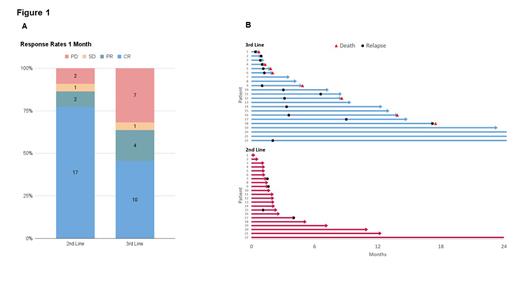Background: Superiority of Axicabtagene Ciloleucel (Axi-Cel) in relapsed/refractory (R/R) large B cell lymphomas (LBCL) compared with standard of care was shown in both the 3 rd and 2 nd line setting. However, optimal timing for incorporation of CAR-T is not well established. We aimed to compare efficacy, toxicity profile, and product kinetics of Axi-Cel as 2 nd vs 3 rd line of treatment. Methods: we performed a national real world retrospective study of consecutive patients treated with Axi-Cel as 2 nd line with propensity score-matched patients treated with 3 rd line treatment. Patients were matched for age (±2 years), Eastern Cooperative Oncology Group (ECOG) performance status, and disease status at lymphodepletion. Disease status and response were defined by the Lugano criteria, cytokine release syndrome (CRS) and immune effector cells-associated neurotoxicity syndrome (ICANS) were defined by ASTCT Consensus (2019) and progression-free survival (PFS) was calculated from infusion to index event. Immunophenotyping from peripheral blood at day 7+ was used to analyze expansion of CAR-T cells. Results: Between 01/2019and 06/2023, 44 patients treated with Axi-Cel fulfilled the inclusion criteria, 22 in each cohort. Groups were well matched in the propensity score domains (mean difference 2, p=.65 for age, mean square .32, p=.57 for ECOG, and mean square .26, p=.61 for disease status at lymphodepletion). Median follow up was 2.2 (range, 1-28.8) months in 2 nd line group and 10.8 (range, 1-39) months in the 3 rd group. Median age was 68 (range, 39 - 84) and 66 (range, 32 - 80) years in the 2 nd and 3 rd line groups, respectively. There were no differences between gender (p=.76), LBCL subtypes (p=.16), % of patients receiving bridging therapy (p=.55), % of patients with elevated LDH levels prior to lymphodepletion (p=.98), and n days from collection to treatment (p=.29) between the 2 groups. There was a lower % of patients with primary refractory disease in the 2 nd, compared to 3 rd line therapy group (63% vs. 36%, respectively, p=.09) and a higher % of patients with transformed disease (42% vs. 14%, respectively, p=.04). Both overall and grade 3-4 incidences of CRS were similar between the 2 nd line and the 3 rd line groups (86% vs. 95%, p=.16 and 18% in both groups, p=1, respectively). Median days to CRS onset was also similar (1, range 0 - 5 and 2, range 0 - 7, p=.1, respectively). Both overall and grade 3-4 incidences of ICANS) were similar between the 2 nd line and the 3 rd line groups (41% vs. 64%, p=.48 and 14% vs. 18%, p=.73, respectively. Median days to ICANS onset was lower in the 2 nd line compared to the 3 rd line group (4, range 0 - 8 and 6, range 0 - 7, p=.06, respectively). There were no differences between the groups in the median tocilizumab doses (p=.21), % of patients receiving steroids (p=.12), cumulative steroids dose (p=.17), % of patients receiving growth factors (p=1), and duration of admission (p=.51). Median day +7 CAR-T blood levels were higher in the 2 nd line compared to the 3 rd line group (126 (range,1-791) vs. 18.1 (range, 0-988) cells/microL, p=.05, respectively). 1-month overall response rate (ORR) was 86% (CR=77%) in the 2nd line group vs 64% (CR=45%), in the 3rd line group, p=.081 Figure 1a. Three-months progression-free survival was 88% (95%, CI 64%-100%) vs. 59% (45%-73%), respectively, Figure 1b. Cox regression identified 2 nd line treatment associated with better progression-free survival (HR=.15, p=.007) and progressive disease at lymphodepletion associated with worse progression-free (HR=8.5, p=.007), while age, gender, and ECOG performance status did not impact progression. Conclusions: This matched comparison showed favorable ORR and PFS rates when Axi-Cel is utilized as a 2nd line treatment vs 3rd line. Toxicity profile is similar. Higher CAR-T expansion in the 2nd line might provide insight regarding product quality and exhaustion phenotype when manufactured earlier in the LBCL treatment course. A longer follow-up is needed to test whether these findings translate to durable remission and cure.
Disclosures
Gurion:Novartis: Honoraria; Roche: Honoraria; Abbvie: Honoraria; Gilhead: Honoraria; Takeda: Honoraria; Medison: Honoraria. Avivi Mazza:AbbVie: Honoraria. Ram:Novartis: Honoraria, Research Funding; Gilead: Honoraria; MSD: Honoraria; BMS, Takeda, Sanofi, Pfizer: Honoraria.


